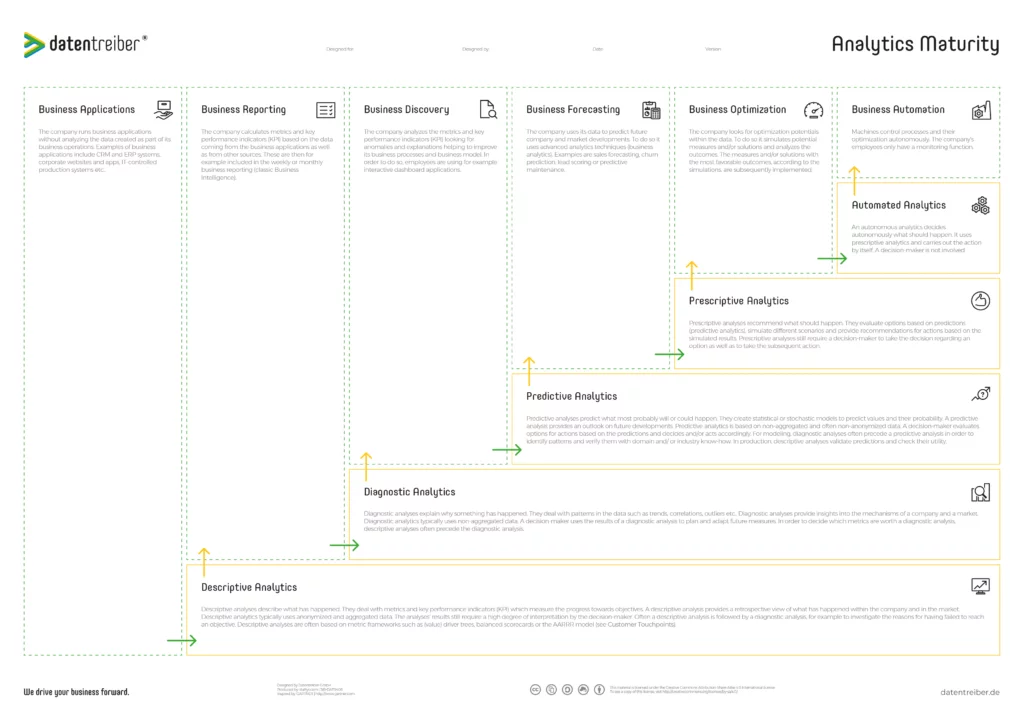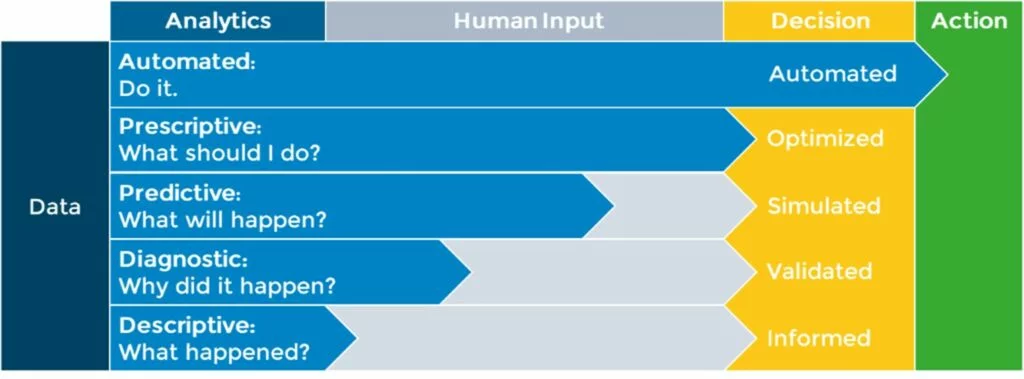The first article in our six-part series on data strategy design focused on setting goals and choosing the right analytics. We then presented the Customer Touchpoints Canvas as a tool for optimizing customer journeys.
The current article familiarizes you with the Analytics Maturity Canvas. It is also being used in the Datengipfel seminars of the strategy consulting firm Datentreiber and, like the complete data strategy designkit of Datentreiber, is available as open source on our website.
The Analytics Maturity Canvas accomplishes two main tasks in developing your roadmap to a data-driven organization. On the one hand, it allows you to visualize the current maturity level of your company or department. Thus, like the other canvas of the designkit, it makes an abstract topic tangible. On the other hand, it is an ideal prioritization tool with which you can gradually increase your analytical maturity level. Both the business side (use cases) and the technical side (tools) are considered.
This holistic approach minimizes the risk of unsuccessful projects or isolated solutions that exist as prototypes distant from your actual business processes.
Note: This article is not a step-by-step guide for using the presented Analytics Maturity canvas. But also for this tool a detailed tutorial for how to work it can be found on our website. Furthermore, the canvas is addressed in the advanced seminar Data Thinking. It is being explored interactively with the participants and there are many opportunities to discuss examples from your own company.
At What Level Is Your Analytics?
The Analytics Maturity Canvas is partly based on the Analytics Maturity model from Gartner. It consists of two areas which allow you to consider the application-oriented and the technical view together.

The upper green area deals with the utilization of data, namely the analytical use cases, and is intended to answer the following questions, among others:
- Which analytical applications are you already using?
- For which purposes are they being used?
The degree of maturity in this area increases from left to right. This boosts the possible added value from the data, but also augments the complexity of the application. In order to illustrate this, two maturity levels are taken as examples:
- Business Reporting: Reporting extracts, combines and aggregates data from different systems. It prepares this data for users in various forms. The information that users obtain from the data is the basis for their actions. Making a decision is one example of such an action. Reports or dashboards for company key figures such as sales or contribution margin can serve as a basis.
- Business Automation: In (intelligent) automation, processes are autonomously controlled by (data-driven) machines and continuously (analytically) optimized. There are no users in the actual sense. Employees only assume a controlling function. Applications such as these can be found, for example, in the field of dynamic pricing or intelligent warehousing in fully automated high-bay warehouses.
The lower yellow area, the refinement of data, answers the question which analytical tools or software systems are required for the applications. Here, the complexity increases from bottom to top. In addition, the individual levels build on each other. You can see this in the following steps described as examples:
- Diagnostic Analytics: Diagnostic analytics answers the question why something happened by showing trends, patterns or correlations. Thus, it mostly shows interdependencies.
- Predictive Analytics: Predictive analytics shows, based on statistical or stochastic models, what will or could happen. Among others, the models make use of the previously identified correlations from diagnostic analytics.
Put simply, the patterns of the past are a good indicator of what will happen in the future. The level of higher maturity thus determines the preceding one. This also applies to all other levels.
When working with the canvas, start by presenting the actual situation of analytics applications and analytics tools. The focus should be set according to your requirements: for example, your entire company, a division or perhaps only one department.
What Is Your Next Best Step?
In our first article we already briefly described which answers the different analytical methods can provide. Depending on the complexity and degree of maturity, the method will bring you closer to the decision or action.

Only when you have an application for a method or tool you can generate added value. Concrete example? If you visualize the current situation on the Analytics Maturity Canvas and find that you have many tools (yellow area) but no applications (green area), you may be wasting money on software without a concrete purpose.
Conversely, if you have many use cases but no suitable tools to implement them, it might be time to prioritize the use cases according to their expected added value. Then, provide the appropriate tools and hire experts for these tools or purchase them from service providers.
Are you having trouble finding data-driven applications? Here, too, tools are already existing: the Analytics Use Case Canvas allows you to identify use cases with corresponding value propositions for your customers.
After completing the analysis of the current situation which should also include applications and tools that are already being implemented or planned, you can develop a step-by-step execution roadmap based on the level of maturity.
Please note that – as mentioned in the previous section – the maturity levels build on each other. You should therefore also plan your analytical maturity process step by step.
Conclusion and Outlook
This third article in our data strategy design series illustrates how to use the Analytics Maturity Canvas to determine your current state in terms of analytics. Using this as a basis, you define your next best step and place it in the context of a roadmap to reach the desired maturity level.
The Data Strategy canvas, covered in the fourth article: With a Data Strategy Against Your Thirst for Information (4/6), helps you to design and concretize the elements of your data strategy.
The Data Landscape canvas is the subject of the fifth article: Explore Your Data Landscape (5/6) . This helps you to clarify the technical requirements for your data strategy.
The sixth and final article: Hit the Sweet Spot With Your Data Strategy (6/6) in the series of articles deals with a complete overview of the Data Strategy Design.
The following other articles have been published in this series:
Note: Author of this article, which was originally published in German language and in full length on the Datentreiber blog, is Martin Raffeiner, Managing Director at datenbotschafter consulting.
Did we awake your interest in the development of data strategies? Then take a look at our Datengipfel Seminars Data Strategy & Culture for beginners and Data Design Thinking for advanced participants. Or contact us if you have any further questions.

